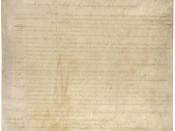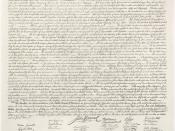The Seven Principle Rules of Law
The seven Rules of Law are clearly seen throughout the Declaration of Independence, the Constitution, and Bill of Rights. All seven principles appear at least once in each document. The common threads that lie within these documents are also the source for their existence. This essay shall address the Principles seen within the previously mentioned documents.
The first principle discusses political authority and the Absolute Rights of life and limb, personal liberty, and private property. This is the contract in which the governed and political authorities are bound. Lastly, that the contact is conditional and both shall operate within the rules.
The First Amendment in the Bill of Rights touches on the first principle. It guarantees freedom of the press, freedom of speech, and freedom of assembly. It also protects the rights of the governed to worship as they please. Provided also is the right to demand change in government policies.
Each of these falling within the Absolute Rights of life, liberty, and limb as stated in the first principle.
The Declaration of Independence also contains sections relating to the first principle. References to unalienable rights of life liberty and the pursuit of happiness appear in the first few lines of the document. It also reads, "That to secure these rights, Governments are instituted among Men, deriving their just powers from the consent of the governed."
The Constitution of the United States has sections also which relate to the first principle. The first article sets the floor plan for which Congress is structured. It also sets rules for who is considered the governed and how they shall be counted. It creates the foundation of authoritative rules.
Principle 2 is more in depth on the authoritative rules. It outlines checks and balances between the legislative,



Principle Rules of Law
You've written a fine essay. Since you discuss seven, not just four, principle rules of law in your essay, perhaps you should amend the essay's title to read: "The Seven Principle Rules of Law."
9 out of 10 people found this comment useful.